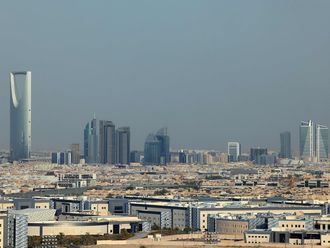Dubai: The Dubai Financial Market General Index (DFMGI) ended higher by 7.01 or 0.18 per cent at 3,864.67. Volume declined to a 12-week low, the lowest level seen in 2015, while there were 15 advancing issues and 22 declining.
This was another week of low volatility, reflected in the narrow weekly range, the second narrowest range since early-October 2014. For a brief period the DFMGI dipped below the prior week’s low of 3,812.29, but did not close below it on a daily basis, which would have been short-term bearish. The DFMGI quickly recovered ending near the upper quarter of a narrow consolidation range that has formed over the past eight-days. Last week’s high-to-low range was 3,886.24 to 3,803.62, and marks the upper and lower boundaries of the eight-day range. A move above and subsequent daily close above the high points to further upside, while a drop below the bottom price level indicates further downside. However, in each case there are additional support and resistance levels nearby to contend with, depending on the direction.
On the upside, the 55-day exponential moving average (ema), which indicates an area of potential resistance, is now at 3,913, and matches previous daily resistance over five days in mid-December 2014. More significant is the recent peak of 3,984.78, followed by the late-December swing high of 4,008.38. A daily close is needed above those price levels to signal a continuation of the uptrend begun from the mid-December low of 2,992.53. If that occurs, the DFMGI would then be heading up into the 200-day ema at 4,180, the mid-October 2014 lows around 4,231, and then the area of 4,385.
Just below last week’s low is a support zone from approximately 3,794 to 3,784, which was either support or resistance on multiple days over the past couple of months. Lower still is a minor level around 3,715.33. That is followed by the more significant 3,628 price area, the swing low from late-January.
Abu Dhabi
Last week the Abu Dhabi Securities Exchange General Index (ADI) was essentially flat, rising only 17.21 or 0.37 per cent to close at 4,686.19. Volume dropped to a 20-week low, while market breadth was even, with 18 advancing issues and 18 declining.
The daily range was narrow until Thursday, when the ADI was up 1.19 per cent, the strongest market in the GCC, and volume popped to an eight-day high. These are short-term bullish signs, but it remains to be seen if upward momentum will continue.
Resistance for the week was at Thursday’s high of 4,690.44, right at the 200-day ema, now at 4,690.97. The 200-day ema stopped an advance in the ADI two weeks ago. This new test could see upside follow-through, but then the index needs to get through resistance at the recent peak of 4,700.68.
Also, as first discussed in last week’s column, the ADI is forming a bearish wedge. The wedge pattern is a relatively narrow ranged upward sloping symmetrical triangle type pattern, where both the top line identifying resistance of the pattern, and the lower line recognising support, are each sloping up and will eventually converge.
The ADI can still go higher and remain within the parameters of the wedge as the convergence of the two lines and the maximum ascent if the wedge is to remain valid, is approximately 4,790. Note that the 4,790 price area is also identified above as potential resistance based on prior support (now potential resistance).
An alternate scenarios is that the ADI continues to rise within a parallel channel, which has been contained within the larger wedge pattern up to this point. The index could break above the top line of the wedge and still remain within the up trending channel. If that happens then the upside potential is greater, and the bearish wedge is invalid. Unfortunately, since the top line identifying the wedge is upward sloping, the price represented by the line will change depending on when price reaches it. It is therefore difficult to determine the resistance price ahead of time unless price is pressing up against the line, which it is not currently doing.
However, a bearish trigger of the wedge can be identified in case the ADI turns down this week. A drop below and subsequent daily close below 4,607.50 can be used for such a signal.
Stocks to watch
Arabtec Holding (ARTC) saw a 890 per cent surge in daily volume last Thursday, reaching a 30-day high. This occurred with price up only 0.06 or 1.94 per cent, closing at 3.16. For the week Arabtec was up only 2.6 per cent. Sometimes, a stock will see a pop in volume before a breakout, and that could be the case here.
For the past couple of the months Arabtec has been consolidating into a large symmetrical triangle pattern. In addition, over the past couple of weeks it has also been pushing up against resistance of both its 55-day ema and medium-term downtrend line, from the 2014 peak.
A bullish breakout of the triangle occurs above 3.26, which will also put the stock back above its moving average and trend line, each an additional bullish sign. It would then be targeting 3.55, then 3.77, and finally the target derived from the triangle of 4.12.
Bruce Powers, CMT, is president of WideVision and chief technical analyst at www.MarketsToday.net. He is based in Dubai.











